Basic AI Chatbot Pricing: A simple chatbot that can answer questions about a product or service might cost around $10,000 to develop.
Read More
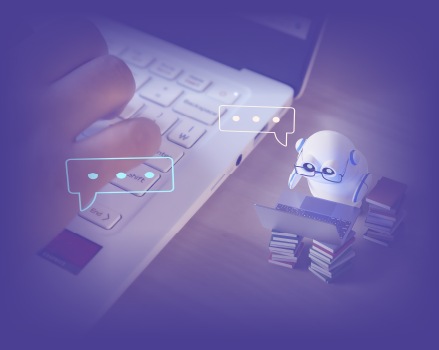
Education AI chatbots are transforming how students learn and engage with digital platforms.
There are two main approaches to building them: modular (custom-built) vs. off-the-shelf solutions.
Key benefits include 24/7 student support, personalized learning, reduced faculty workload, and higher course completion rates.
Common use cases span K-12, higher education, EdTech startups, and corporate learning platforms.
The cost for custom education AI chatbot development ranges from $8,000 to $30,000+ depending on features and integrations.
The global AI in education market is projected to reach $20 billion by 2027.
AI is reshaping how we live, work—and now, how we learn.
From personalized tutoring to automated student support, AI-powered chatbots are making their mark in education. They’re not just a trendy add-on anymore. They’re becoming essential tools for learning platforms, schools, and EdTech startups.
Whether it’s answering student queries at 2 AM, helping navigate a course module, or assisting instructors with admin tasks—education AI chatbot development is changing the game.
And the best part?
It’s just getting started.
In this blog, we’ll explore how AI chatbots are being used in education, what makes them valuable, how you can build one, and what it might cost. We’ll also help you figure out whether an off-the-shelf chatbot will do the trick—or if you need something custom-built for your platform.
Let’s dive in.
An educational AI chatbot is like a virtual assistant built specifically for learning environments.
It’s designed to help students, teachers, and even administrators—right inside apps, websites, or learning platforms. Not only this, here’s a complimentary read for you to explore 18 use cases of AI chatbots in education.
These chatbots use artificial intelligence (AI), often powered by natural language processing (NLP), to understand what users are saying.
Then they respond just like a human would—only faster and more consistently.
But here’s what makes them special.
Unlike generic bots, an educational AI chatbot understands academic workflows. It knows when to suggest a study resource, how to guide a student through a lesson, or what to do when someone’s confused.
They can:
Some schools use them for onboarding.
Others build education AI chatbot to have entire learning journeys around them.
Whether you’re a university, an online academy, or an EdTech startup, educational AI chatbot development helps you create a smarter, more supportive learning experience.
And with the right strategy, these bots can become your platform’s most valuable teaching partner.
Leverage the experience of a trusted Custom AI App Development Company in the USA to turn your vision into a smart, scalable solution.
Request a Free Consultation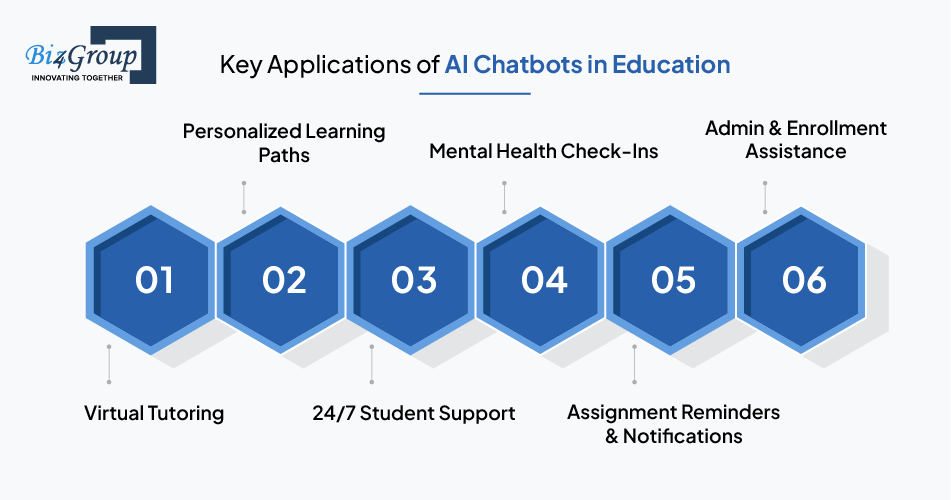
AI chatbot for learning platforms aren’t just answering FAQs anymore.
They’re becoming active contributors to the learning experience.
Whether you’re running a school portal, an online course, or a training platform, there are plenty of ways to put a chatbot to work.
Here are some of the most common (and useful) applications:
Students can ask questions and get instant explanations.
No need to wait for office hours or dig through textbooks.
Chatbots can guide learners step-by-step through problems.
Especially helpful in subjects like math, coding, or language learning.
Moreover, explore the future of education by going through this complimentary read on what AI integration in education would do to students’ careers.
The chatbot can track how a student is progressing.
It then suggests new topics, quizzes, or resources based on performance.
This keeps learners motivated—and helps reduce drop-off.
Need to reset a password?
Can’t find your course schedule?
Instead of emailing someone or waiting for help, students just ask the chatbot.
Quick answers. Less frustration.
And support is available anytime.
Some educational platforms are using bots to gently check in on students’ well-being.
It’s not a replacement for counselors, but it’s a step toward building a more caring system.
Chatbots can ping students about upcoming deadlines, exam schedules, or even feedback from instructors.
It’s like having a digital study buddy who’s always on top of things.
New students often have tons of questions.
A chatbot can help them register, find course material, or understand campus policies.
This saves the admin teams hours every week.
No matter the use case, these bots bring real value when designed with the learner in mind.
That’s why so many platforms today are investing in AI chatbot development for learning platforms—not just to automate, but to enhance how people learn.
Thought of how you’re going to use AI chatbot for educational purpose? Then, explore Biz4Group’s GPT 4 AI-powered chatbot and how you can integrate as per your requirements.
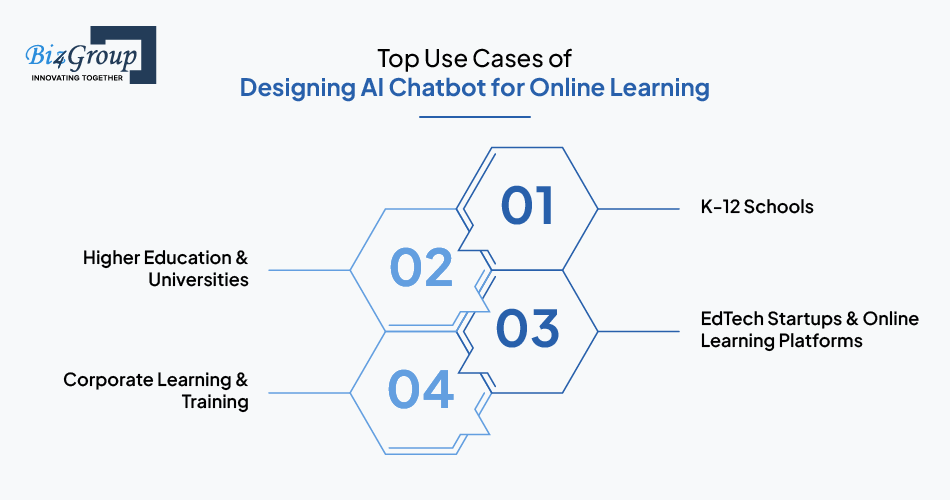
AI chatbots are flexible.
They’re not limited to one type of institution or learning style.
From traditional classrooms to corporate training, these bots are showing up everywhere.
Here’s how different sectors are putting them to work:
In primary and secondary schools, chatbots often support students outside class hours.
They help with:
They’re also great for answering basic questions like “What’s the lunch menu today?” or “When is the science fair?”
For younger students, bots can even be gamified—making learning more fun and interactive.
Universities are using chatbots to improve everything from admissions to academic support.
Think about it:
An AI chatbot streamlines all that—and frees up time for faculty and staff.
Plus, some universities use chatbots as virtual TAs, especially in large lecture-based courses.
This is where chatbots really shine.
For online platforms, user experience is everything.
Chatbots make sure learners stay engaged, feel supported, and get nudges to stay on track.
They’re used for:
If you’re looking to develop a chatbot for eLearning, this is one of the most impactful spaces to do it.
Chatbots also work well in workplace training programs.
They help employees:
Instead of digging through documents, employees can just ask the chatbot.
That’s faster, simpler, and a lot less painful.
No matter the sector, the goal is the same:
Create an interactive chatbot for student (or learner) support that boosts outcomes and reduces friction.
The beauty of AI is—it scales.
One chatbot can help hundreds or thousands of learners, without missing a beat.
Partner with a team that understands both technology and learning. Let’s create an AI chatbot that supports, teaches, and grows with your platform.
Let’s Connect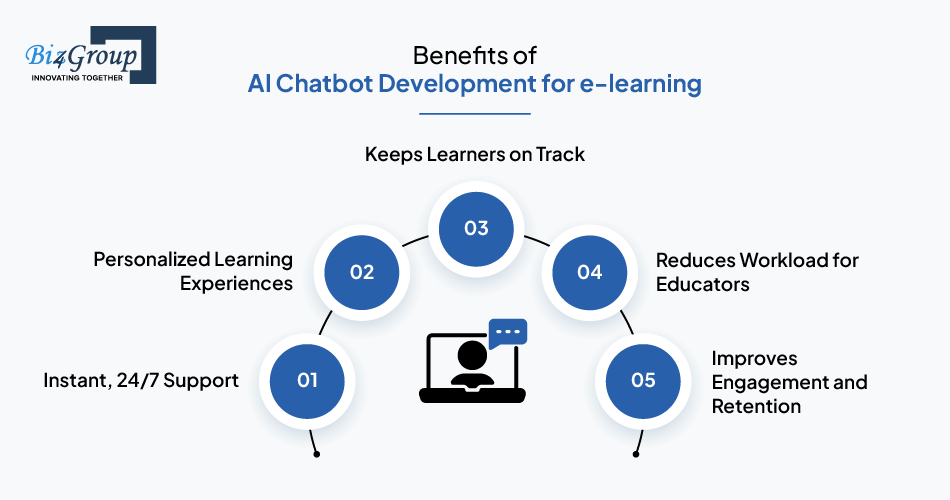
Let’s be real—learning online can sometimes feel a little lonely.
Students get stuck. Questions pile up. And instructors can’t be everywhere at once.
That’s where chatbots come in.
When you design an AI chatbot for online learning, you're not just adding tech—you’re improving the entire learning experience.
Here’s how:
Students don’t always study during school hours.
Sometimes it’s midnight, and they need help before a big test.
A chatbot is always available.
No waiting. No emails. Just answers, right when they’re needed.
Not all students learn the same way.
Some move fast. Others need more support.
A smart AI chatbot can adjust its tone, recommend resources, and guide learners based on how they’re performing.
That means more relevant help—and better results.
Meanwhile, here’s a relevant guide on AI conversation chatbot challenges & solutions.
Deadlines. Assignments. Quizzes.
Chatbots can send reminders, give updates, and even celebrate wins when a student finishes a milestone.
It’s like having a motivational coach baked right into your platform.
Instead of answering the same questions over and over, teachers can let the chatbot handle routine queries.
That gives educators more time to focus on what matters—teaching and supporting their students.
When students feel supported, they’re more likely to stick with a course.
By offering quick help, personalized suggestions, and friendly nudges, chatbots can reduce drop-off rates and boost completion numbers.
It’s a win-win for learners and platforms.
If you're serious about creating an interactive chatbot for student support, these benefits are hard to ignore.
They don’t just make things easier—they make learning better.
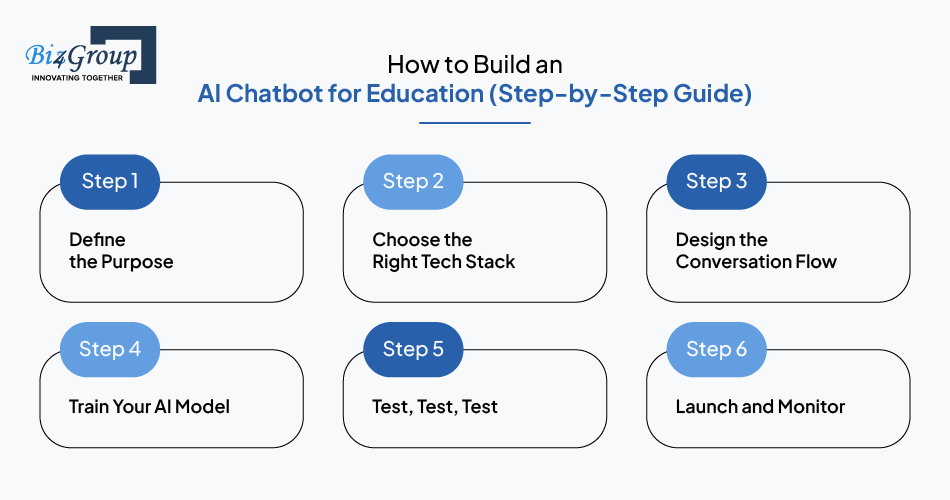
So, you’re ready to build an AI chatbot for education.
Awesome.
But where do you start?
Whether you’re building for a school, an LMS, or an EdTech app, the process follows a few core steps.
Here’s how to do it—without the overwhelm.
What do you want your chatbot to do?
Start by listing your top goals.
This sets the direction for everything else.
Time to pick your tools.
You’ll need:
|
Component |
Purpose |
Popular Tools/Technologies |
|
Frontend/UI |
User interface for web or mobile |
React, Angular, Vue.js, Flutter, HTML/CSS |
|
Backend |
Handles logic, APIs, user management |
Node.js, Python (FastAPI/Django), Express.js |
|
Chatbot Framework |
Manages conversation flows and responses |
Google Dialogflow, Rasa, Microsoft Bot Framework |
|
AI/NLP Engine |
Understands natural language and intent |
OpenAI GPT, Google BERT, Rasa NLU, IBM Watson NLP |
|
Database |
Stores user data, conversations, and logs |
MongoDB, PostgreSQL, MySQL, Firebase |
|
LMS Integration |
Connects to learning platforms |
Moodle API, Canvas API, Blackboard API, SCORM |
|
Authentication |
Secure user login and session handling |
Firebase Auth, OAuth 2.0, Auth0 |
|
Analytics & Monitoring |
Tracks usage, performance, and user satisfaction |
Google Analytics, Mixpanel, Microsoft App Insights |
|
Hosting/Deployment |
Runs and scales the application |
AWS (EC2, Lambda), Google Cloud, Azure, Vercel |
|
Messaging/Live Chat |
Enables real-time support when escalation is needed |
Twilio, Tawk.to, Intercom, SendBird |
If you're not sure where to begin, a good education AI chatbot development partner can help here.
FYI, if you’re planning to develop chatbot for eLearning using Python, Biz4Group is also renowned as a Python development company in USA.
Now, map out how the chatbot will talk.
Think through:
Keep it clear. Keep it helpful.
And make sure the tone matches your brand and audience.
This is where NLP (Natural Language Processing) comes in.
You’ll feed the chatbot examples of how students might ask the same question in different ways.
That helps it respond accurately—even when the wording changes.
This is especially important for developing AI chatbots for the educational industry, where the same question can be asked in a dozen ways.
Before launch, run the chatbot through real-life scenarios.
Get feedback from students, instructors, and admins.
Find out what works—and what needs tweaking.
It’s way better to catch issues now than after you’ve gone live.
Once you’re confident, it’s go time.
But don’t stop there.
Monitor how users are interacting. Look at analytics. Keep improving.
AI gets smarter with time—so treat this like a living part of your platform.
That’s how you build an AI chatbot for education that actually works.
It’s not just about the tech—it’s about solving real problems for learners.
And when you get it right?
The results speak for themselves.
So, you’ve decided to bring a chatbot into your learning platform.
But here’s the big question: Should you go custom, or choose an off-the-shelf solution?
Both options have their place.
It really comes down to your goals, your budget, and how flexible you want your chatbot to be.
Let’s break it down.
This is the build-from-scratch route.
You get full control over how the chatbot looks, behaves, and integrates with your systems.
If you're aiming to design an AI chatbot for online learning that does more than just answer FAQs, modular is the way to go.
These are pre-built chatbot tools, often SaaS-based, that you can quickly plug into your system.
But here’s the catch:
They’re limited. You may not be able to customize the chatbot’s behavior deeply or integrate it cleanly with your platform.
So, while they’re great for testing the waters, they can become restrictive if your needs grow.
If you’re just experimenting or need basic automation, off-the-shelf could be enough.
But if you want your chatbot to become a real part of the learning experience—and grow with your platform—a modular, custom-built chatbot is the smarter investment.
Especially if you're serious about creating an interactive chatbot for student support that does more than just talk—it guides, teaches, and adapts.
Also Read: Building Custom Chatbots Using Google Cloud Platform (GCP)
From intelligent student support to personalized learning paths, we design chatbots that actually make learning easier and more effective.
Book a free appointmentSo, how much does it cost to build an AI chatbot for education?
Well… it depends.
(Not the answer you were hoping for, right?)
But hang in there—we’ll break it down so you can get a realistic sense of what affects pricing, and where your budget is best spent.
The more your chatbot can do, the more it’ll cost.
A simple FAQ bot with pre-defined answers?
Much cheaper.
But a chatbot that offers personalized tutoring, integrates with your LMS, supports multiple languages, and uses NLP to interpret messy student questions?
That’s going to need a larger investment.
As we mentioned earlier, off-the-shelf bots have a lower upfront cost—often around $100–$500/month for basic functionality.
But custom-built chatbots—designed from scratch for your platform—typically range from $8,000 to $30,000+, depending on:
You're not just paying for the bot—you’re paying for an AI solution that fits your exact goals.
Need your bot to connect with Moodle, Canvas, or your internal student information system?
That adds some development time.
More time = more cost.
But this is often worth it, because integrations improve the user experience dramatically.
Training your bot to understand educational language, slang, and learning behaviors takes effort.
Especially if you want it to recommend content or respond intelligently to student moods.
More advanced AI = higher initial cost—but also a lot more value long term.
Launching the bot isn’t the end—it’s just the beginning.
You’ll want regular updates, monitoring, and maybe even feature expansions down the line.
Some teams handle this in-house, others go with a managed service plan.
Either way, it’s smart to factor this into your budget.
| Type | Estimated Cost |
|---|---|
| Off-the-shelf chatbot | $100 – $500/month (subscription) |
| Basic custom chatbot | $8,000 – $15,000 |
| Mid-level chatbot (NLP + LMS integration) | $15,000 – $25,000 |
| Advanced chatbot (AI, multilingual, analytics) | $25,000 – $40,000+ |
At the end of the day, education AI chatbot development is an investment in better learning, better engagement, and better support.
And with the right approach?
It pays off quickly.
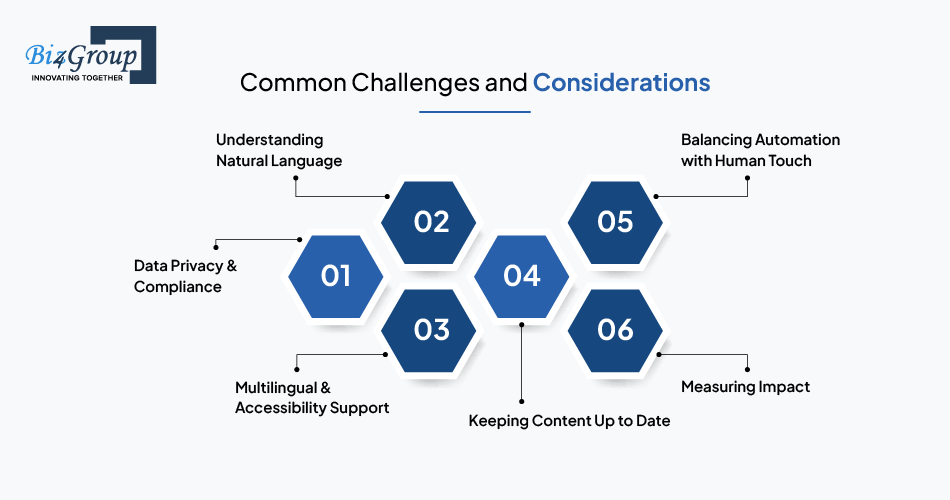
Building a chatbot for education is exciting, but it’s not always smooth sailing.
There are a few bumps you’ll want to watch out for.
Some are technical. Others are about user behavior.
And a few? They’re about making sure your bot doesn’t just work—it works well for learners.
Here’s what to keep in mind:
When you’re handling student data, privacy isn’t optional.
Depending on where you operate, you may need to comply with rules like:
That means being careful about what info your chatbot collects, stores, and shares.
Encryption, clear data policies, and opt-in permissions are a must.
Students don’t always phrase things perfectly.
They misspell. They ask casually. They use slang.
Your chatbot needs to keep up.
Training it with real-world input and using strong NLP models is key—especially when you’re developing AI chatbots for the educational industry.
If your platform serves a diverse audience, your chatbot should too.
That means supporting multiple languages.
And also designing for accessibility—like screen readers, voice input, or simple language options for younger learners.
Education moves fast.
Courses change. Schedules shift. Policies update.
If your chatbot is feeding old info to users, it hurts trust.
That’s why regular updates and an easy content management setup are so important.
Not every question should be answered by a bot.
When a student is struggling emotionally or facing something complex, they should be gently routed to a real person.
A good chatbot knows its limits—and hands things off when needed.
It’s easy to launch a chatbot and forget about it.
But you should be asking:
Set goals. Track results. Improve over time.
These challenges aren’t deal-breakers.
But they are deal-shapers.
The more thought you put into solving them early, the better your custom chatbot for education will perform—and the more value it will bring.
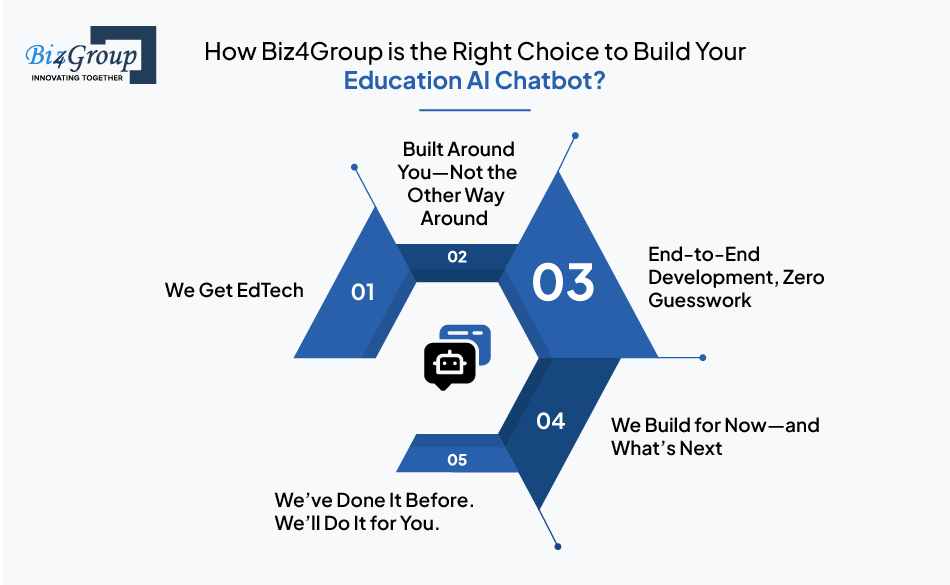
Let’s face it—anyone can throw together a chatbot with a few templates.
But building an AI chatbot for education that truly helps students learn, supports teachers, and grows with your platform?
That takes experience, strategy, and a deep understanding of how learning works.
That’s where Biz4Group, an AI development company comes in.
Our team has worked with schools, universities, EdTech startups, and corporate learning platforms.
We don’t just build bots—we build learning companions that boost engagement, retention, and support.
If you’re looking to build an education AI chatbot that’s more than a help desk, we’re ready to make it happen.
We don’t do cookie-cutter.
Your platform is unique.
Your learners are unique.
So, your chatbot should be too.
We help you create a custom chatbot for education that fits your tech stack, your tone, and your long-term goals.
From brainstorming to post-launch improvements, as an AI chatbot development company, we’ve got your back.
Here’s what we handle:
And we keep you in the loop every step of the way.
Want a simple chatbot to start? Cool.
Want to add voice, analytics, or multilingual support later? We’ll plan for that too.
Our modular approach means you never outgrow your chatbot.
You evolve it—just like your learning platform.
If you’re serious about implementing a chatbot in education, we’re here to help you do it right.
Let’s build something that doesn’t just answer questions…
It drives better learning outcomes.
We build custom chatbots for education that are easy to use, deeply integrated, and built to scale as your needs evolve.
Let’s ConnectAI isn’t just changing the way we work—it’s transforming how we learn.
And at the heart of that change? Chatbots.
When done right, educational chatbots aren’t just digital tools.
They’re learning companions. Mentors. Study buddies. Problem solvers.
They help students stay engaged, give educators more breathing room, and make learning platforms feel more human.
Whether you’re running a school, launching an EdTech product, or scaling your training programs—education AI chatbot development gives you an edge.
But it’s not about throwing in the latest tech for the sake of it.
It’s about using AI to make education more accessible, more personalized, and more effective.
If you’re thinking about creating your own chatbot—modular, scalable, and built for your learners—we’d love to help.
Let’s talk about how we can build or integrate an AI chatbot for your education platform—one that’s smart, supportive, and ready to grow.
Costs can range from $8,000 for a basic custom bot to $30,000+ for an advanced, AI-powered chatbot with LMS integration, multilingual support, and analytics.
Off-the-shelf bots usually cost $100–$500 per month.
Depending on the complexity, it can take anywhere from 4 to 12 weeks. This includes planning, design, development, testing, and deployment.
Most modern chatbots can integrate with popular LMS platforms like Moodle, Canvas, Blackboard, and custom-built systems.
They can also connect to CRMs, email tools, and content libraries.
Yes—when designed well, chatbots can boost engagement, reduce student frustration, and keep learners on track with personalized guidance and reminders.
Off-the-shelf chatbots are pre-built tools with limited customization. Modular (custom-built) bots are designed specifically for your learning experience, allowing deeper personalization, better integration, and more flexibility.
with Biz4Group today!
Our website require some cookies to function properly. Read our privacy policy to know more.